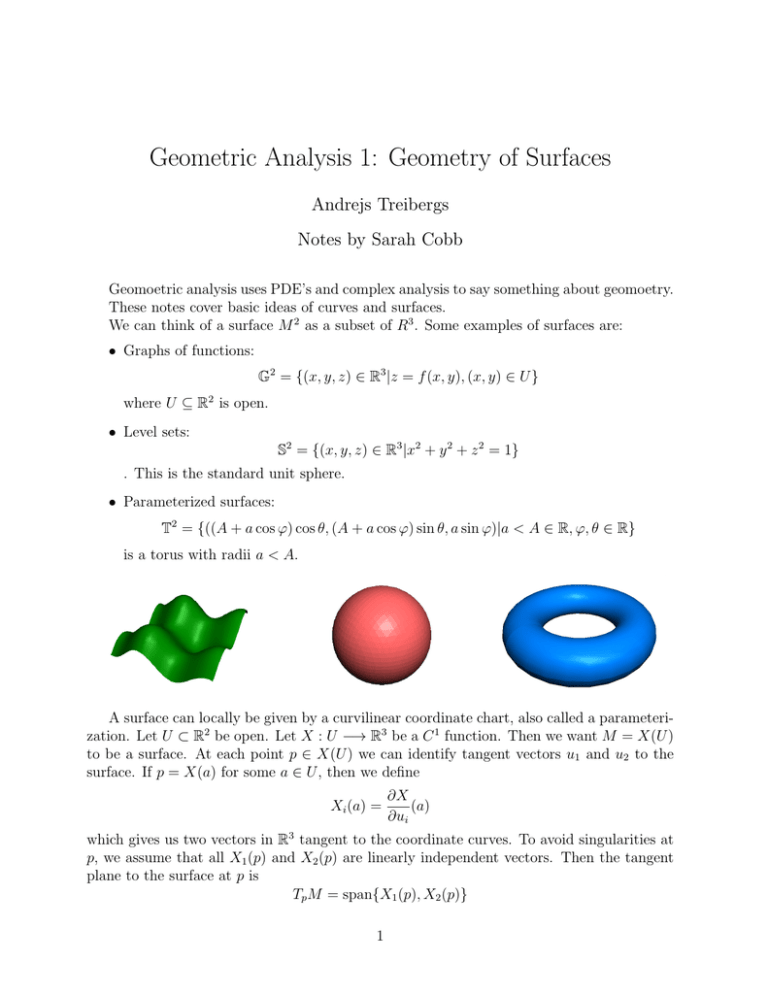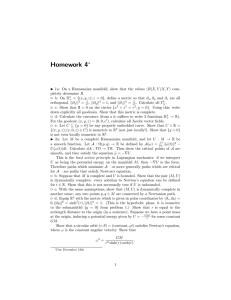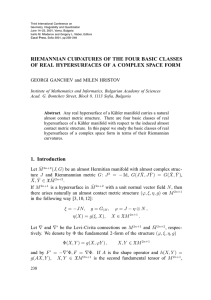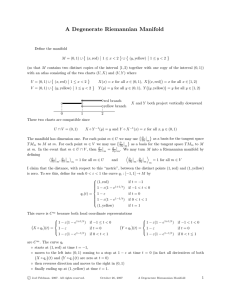Geometric Analysis 1: Geometry of Surfaces Andrejs Treibergs Notes by Sarah Cobb
advertisement

Geometric Analysis 1: Geometry of Surfaces
Andrejs Treibergs
Notes by Sarah Cobb
Geomoetric analysis uses PDE’s and complex analysis to say something about geomoetry.
These notes cover basic ideas of curves and surfaces.
We can think of a surface M 2 as a subset of R3 . Some examples of surfaces are:
• Graphs of functions:
G2 = {(x, y, z) ∈ R3 |z = f (x, y), (x, y) ∈ U }
where U ⊆ R2 is open.
• Level sets:
S2 = {(x, y, z) ∈ R3 |x2 + y 2 + z 2 = 1}
. This is the standard unit sphere.
• Parameterized surfaces:
T2 = {((A + a cos ϕ) cos θ, (A + a cos ϕ) sin θ, a sin ϕ)|a < A ∈ R, ϕ, θ ∈ R}
is a torus with radii a < A.
A surface can locally be given by a curvilinear coordinate chart, also called a parameterization. Let U ⊂ R2 be open. Let X : U −→ R3 be a C 1 function. Then we want M = X(U )
to be a surface. At each point p ∈ X(U ) we can identify tangent vectors u1 and u2 to the
surface. If p = X(a) for some a ∈ U , then we define
Xi (a) =
∂X
(a)
∂ui
which gives us two vectors in R3 tangent to the coordinate curves. To avoid singularities at
p, we assume that all X1 (p) and X2 (p) are linearly independent vectors. Then the tangent
plane to the surface at p is
Tp M = span{X1 (p), X2 (p)}
1
Definition. A connected set M ⊂ R3 is a regular surface if for each p ∈ M there is a
neighborhood V ⊂ R3 and map X : U −→ V ∩ M of an open set U ∈ R2 onto V ∩ M such
that
1. X : U −→ V ∩ M is a smooth homeomorphism.
2. X1 (U ) and X2 (U ) are linearly independent for all u ∈ U .
The function X is called a chart and can be used to establish a local coordinate system
on the manifold.
Suppose S ⊂ R3 is a surface and at p ∈ S there are two charts ϕ : U −→ S and ψ : V −→ S
such that U and V are open subsets of R2 and p ∈ ϕ(U ) ∩ ψ(V ). Let u ∈ ϕ−1 (ψ(V )). We
can define the transition function v = ψ −1 (ϕ(u), which gives the change of coordinates map.
The Inverse Function Theorem guarantees that these maps are smooth and invertible.
To talk about surfaces, it is important to consider when two surfaces are essentially the
same. Different kinds of equivalence are extablished by different kinds of functions between
surfaces.
Definition. Two surfaces M and N are diffeomorphic if there is a function f : M −→ N
such that f is invertible and both f and f −1 are smooth.
To abstract the idea of a regular surface, we drop the requirement that M ⊂ R3 . We
define a differentiable manifold as a topological space M that has a collection of coordinate
charts whose transition functions are smooth and consistently defined. The atlas of charts
with corresponding transition functions is called a differential structure.
The question naturally arises of whether differentiable manifolds exist that do not arise
as submanifolds of Euclidean space. Whitney’s embedding theorem answers this question in
the negative, as long as we allow larger codimensions.
Whitney’s Embedding Theorem. Let M n be a differentiable manifold of dimension n
and N ≥ 2n + 1. Then M n is diffeomorphic to some W n ⊂ RN , an embedded regular
submanifold.
The Euclidean structure of R3 , the usual dot product, gives a way to measure lengths
and angles of vectors. If V = (v1 , v2 , v3 ), then its length
q
√
|V | = v12 + v22 + v32 = V · V
If W = (w1 , w2 , w3 ), then the angle α = ∠(V, W ) is given by
cos α =
V ·W
|V ||W |
If γ : [a, b] −→ M ⊂ R3 is a continuously differentiable curve, its length is
Z
b
|γ̇|dt
L(γ) =
a
If the curve is confined to a coordinate patch γ([a, b]) ⊂ X(U ) ⊂ M , then we may factor
through the coordinate chart. There are continuously differentiable u(t) = (u1 (t), u2 (t)) ∈ U
so that γ(t) = X(u1 (t), u2 (t)) for all t ∈ [a, b]. Then the tangent vector my be written
γ̇(t) = X1 (u1 (t), u2 (t))u̇1 (t) + X2 (u1 (t), u2 (t))u̇2 (t)
so its length is
|γ̇|2 = X1 · X1 u̇21 + 2X1 · X2 u̇1 u̇2 + X2 · X2 u̇22
For i, j = 1, 2 the Riemannian metric is given my the matrix function gij (u) = Xi (u) · Xj (u).
Evidently, gij (u) is smoothly varying, symmetric, and positive definite. Thus
2
|γ̇(t)| =
2 X
2
X
gij (u(t))u̇i (t)u̇j (t)
i=1 j=1
The length of the curve on the surface is determined by its velocity in the coordinate
patch u̇(t) and the metric gij (u).
A vector field on the surface is also determined by functions in U using the basis. Thus
if V and W are tangent vector fields, they may be written
V (u) = v 1 (u)X1 (u) + v 2 (u)X2 (u)
and
W (u) = w1 (u)X1 (u) + w2 (u)X2 (u)
The R3 dot product can also be expressed by the metric:
V · W = hV, W i =
2
X
gij v i wj
i,j=1
where h·, ·i is an inner product on Tp M that varies smoothly on M . This Riemannian metric
is also called the First Fundamental Form.
If V and W are nonvanishing vector fields on M then their angle α = ∠(V, W ) satisfies
cos α =
hV, W i
|V ||W |
which depends on the coordinates of the vector fields and the metric. If D ⊂ U is a piecewise
smooth subdomain in the patch, the area if X(D) ⊂ M is also determined by the metric
Z q
Z
|X1 × X2 |du1 du2 =
det(gij (u))du1 du2
A(X(D)) =
D
D
since if β = ∠(X1 , X2 ), then
|X1 × X2 |2 = sin2 β|X1 |2 |X2 |2
= (1 − cos2 β)|X1 |2 |X2 |2
= |X1 |2 |X2 |2 − (X1 · X2 )2
2
= g11 g22 − g12
For the graph G2 = {(x, y, z)
X(u1 , u2 ) = (u1 , u2 , f (u1 , u2 )). The
g11
g21
where fi =
∂f
.
∂ui
∈ R3 : z = f (x, y) and (x, y) ∈ U } take the patch
metric components are gij = Xi · Xj so
g12
1 + f12 f1 f2
=
f1 f2 1 + f22
g22
This gives the usual formula for area
det(gij ) = 1 + f12 + f22
so
Z q
A(X(D)) =
1 + f12 + f22 du1 du2
D
If we endow an abstract differentiable manifold M n with a Riemannian Metric, a smoothly
varying inner product on each tangent space that is consistently defined on overlapping
coordinate patches, the resulting object is a Riemannian Manifold.
Now that we have a metrics on manifolds, we can define equivalence between manifolds in
a narrower way. Two manifolds are isometric if there is a distance-preserving map between
them.
As before, the question arises of whether there are Riemannian manifolds that do not arise
as submanifolds of Euclidean space with the induced differential structure and Riemannian
metric. Provided we allow sufficiently large codimension, such manifolds do not exist, as
shown by Nash.
Nash’s Isometric Immersion Theorem. Let M n be a smooth Riemannian manifold of
dimension n and N ≥ n2 + 10n + 3. Then M n is isometric to a smooth immersed manifold
W n ⊂ RN with induced Riemannian metric.


